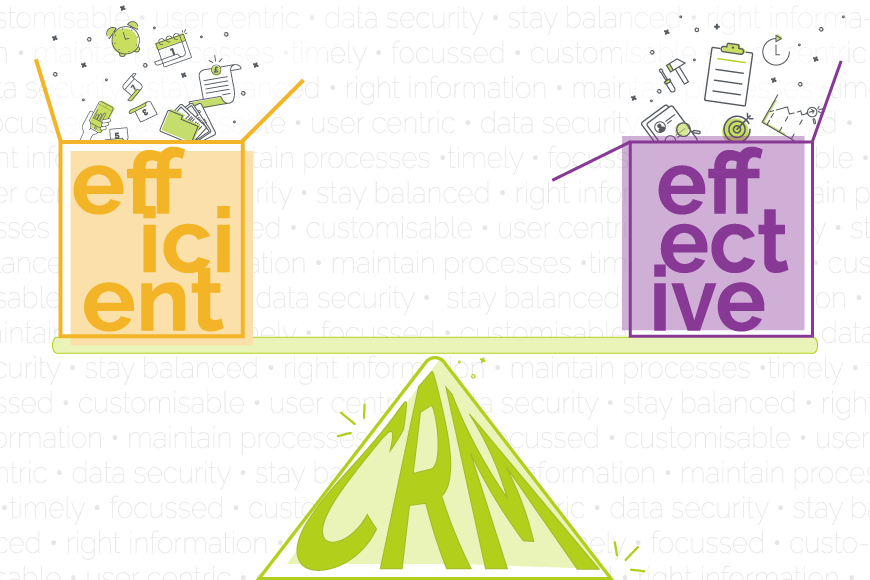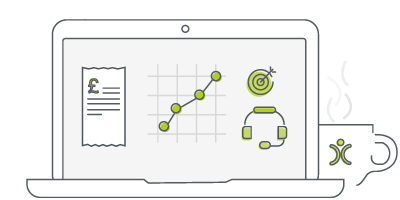Efficiency and Effectiveness: A Balancing Act with CRM in the Middle
5 Nov 2019
Two words that managers love to use when trying to motivate their team (or encourage their performance). But what is the difference between being efficient and being effective? Can you have both?
Let’s start with some definitions:
- Efficiency – Completing your tasks without wasted time, effort, or other resources
- Effectiveness – Always following the exact right process on each task and getting exactly the right outcome
The two feel very similar I know. I like to think of them in terms of how people cook a meal. An efficient cook will get everything on the table right on time, it will all taste fine, and no food will end up in the bin that could have been eaten. An effective cook, on the other hand, will produce a meal that tastes amazing, but it might be late and they may have thrown out ingredients that didn’t turn out perfectly.
Now some tasks, you might encourage your team to be as effective as possible. In other cases, efficiency is more important. Obviously, you really want every task to be done both efficiently and effectively, but that just isn’t always possible.

Don't just take our word for it
Click to read how other companies have benefited from using OpenCRM. From out-of-the-box implementations to businesses that needed bespoke development to fit their unique approach - we've seen it all.
find out moreA Supporting Example
I’m going to explore a scenario to help illustrate the difference between the two.
Let’s say that one of your customers gets in touch with your customer service team with a question about setting up some training for a new member of their team.
Efficient User | Effective User | |
Step 1 | Confirms a good date/time with the customer | Documents what the training will be covering |
Step 2 | Checks the account that the customer has enough time against their account | Asks the customer’s account manager if this training session will be covered by what is currently in the kitty |
Step 3 | Scrolls through the trainers’ calendars to find one that has a slot that matches the customer’s request | Confirms with the customer that they have sufficient credits in their account for this training |
Step 4 | Finds out what the training will be covering and booking it in. – Done | Forwards the training request to the manager in charge of scheduling these kinds of sessions |
Step 5 | …makes a cup of tea | This manager comes back with a list of people who would be good at this type of training |
Step 6 | …has a chat with a colleague | Goes back to the customer to find out the best time |
Step 7 | …picks up the next customer request | Books in the training – Done |
You can see how the extra steps in the Effective User’s process will take longer, but will be more accurate at the end of the day. They’ll get the right person for the training and their account manager will be in the loop right from the start. However, any back and forth will make the customer wait even longer for that actual training session.
The Efficient User has the session booked much sooner, so the customer is probably happier. It does mean that both the account and training managers are out of the loop…and our Efficient User may have got a trainer booked in who isn’t actually great at dealing with brand new users.
Ideally, you want a process that allows your customer service user to be both effective and efficient…maybe something that transfers some of the organisation over to the trainer?
Who knows…the important thing is recognising that both users have accomplished the task. One did it by taking on a lot of responsibility and getting the request resolved quickly. The other involved a lot more people and spent longer resolving the request, but essentially got the perfect result.

Looking for a quick overview?
Sometimes all you are looking for is a quick video to give you a feel for the software you're investigating. Well search no further. Just click the button, sit back, relax, and watch our quick overview video.
watch nowDo you always have to choose between efficiency and effectiveness?
Now I’ve used an example that essentially means that our poor customer service person has to decide whether they want to be efficient or effective.
And quite often, that is the reality…we all make decisions about whether we want to follow the exact process or try to get the task off our desks sooner.
As a manager, however, part of my responsibility is reviewing our processes (and the tools we use to manage these) to make sure that my team aren’t forced into this decision.
How CRM can help with the balancing act
CRM systems exist to help you run your business efficiently and effectively. But how can it help your users maintain a healthy balance between carrying out their tasks effectively, without having to sacrifice efficiency?
Customisation
Making sure you have all the right fields to hold the information that is important and sometimes unique to your business is a good start to working effectively.
But to make these custom fields efficient, you have to have them set up on screen in a way that helps your team do their jobs without wasting any time searching for the information they need.
You may even want different layouts for different departments to make sure different people have everything laid out nicely so they can to work efficiently and effectively.
Similarly, custom views do this for the home screens – showing different people, different bits of your data in a different order depending on what they need to get out of it.
Bringing information to focus
Using tools like our Timeline and keyword searching, we make sure that different people can focus on different tools in different areas of the system – tailoring their experience for their job role.
The Timeline lets people view all the recent things that have happened with their records. Each user can then decide whether it is visible on screen for each module and which areas of the systems are highlighted within it.
So for example, your sales people might want to see only recent Activities and Emails on their Opportunities. But your finance team might prefer to view Companies without the Timeline, but when they do expand it, the Invoices are the only thing presented.
I don’t want to go into it here…this blog is already long enough…but Reports and Dashboards also give you and your team overviews of data that is important to you.
It’s all about the right info at the right time.
Before I got my start in the tech industry as part of Apple’s UK Mac launch team, I was a professional drummer (notice I didn’t say musician). But once I got in, I was hooked and I’ve been involved in the tech industry, primarily software development, for over 20 years. I founded this company and I now have the enviable title of System Architect (as well as Managing Director) here at OpenCRM.